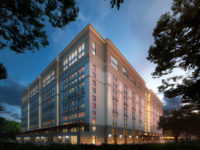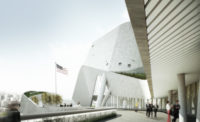
When Peter Wynne Rees became the chief planner of the City of London in 1985, the famous “square mile” had only one hotel, at Liverpool Street Station, with rooms, he says, that bankers rented by the hour. Now two of the City’s most important Edwardian buildings are becoming luxury hotels. The conversion of the former headquarters of the Port of London Authority in Trinity Square, near the Tower of London, and the Midland Bank Head Office, designed by the great architect Sir Edwin Lutyens, will bring the number of hotel rooms in the City to almost 6,000.
Rees, a Welsh-born architect who has held the planning job for 27 years, can take much of the credit for the City’s hotel boom. But his most visible and controversial legacy may be the skyscrapers that have been sprouting up around the City—a cluster of towers with nicknames like the Cheese Grater, the Scalpel, and the Can of Ham. That one, actually 122 Leadenhall Street, by Rogers Stirk Harbour and Partners, topped out at over 700 feet in June.
Preservationists are concerned that views to and from key landmarks, including St. Paul’s Cathedral, are being compromised, and some see Rees as a cheerleader for developers. Last summer, UNESCO urged the governments of greater London, which includes the City and 32 surrounding boroughs, to exercise “extreme caution” when approving buildings that will be visible from within the Tower of London. If too many new buildings intrude, UNESCO warned, it could revoke the Tower’s world heritage status.
The Shard, the pyramidal Renzo Piano skyscraper, now the tallest building in Europe, already dominates views from the center of the Tower. The Shard is south of the river and not in the City of London, putting it outside Rees’s jurisdiction. (He did object to its intrusion into a protected view corridor.) By contrast, he says, the skyscrapers he has approved in the City are clustered, to minimize their impact on the skyline. More importantly, their point isn’t to show off, but to meet the needs of financial service firms for close proximity. “People could do most of their jobs from home. The reason they come to the City,” he says, “is to be near each other, which allows for the gossip, the stuff that nobody would dream of saying over the phone or in an email.”
Some of the new buildings in the City qualify as world-class architecture. After the Gherkin, Norman Foster’s once controversial, now loved prismatic pickle, came the Heron Tower, by New York’s Kohn Pedersen Fox (whose principal Bill Pedersen said he has “never come out of a meeting with Rees that didn’t result in a better building”), and the new Rothschild Bank headquarters, by the Dutch architect Rem Koolhaas of OMA. Among those now under construction are the headquarters of Bloomberg, also by Foster, and the KPF-designed Scalpel. There is less quality control outside the City, which has resulted in, among other embarrassments, a monstrosity called the Strata, an apartment building south of the river in the Elephant & Castle neighborhood, topped by three huge wind turbines that can’t be used because their vibrations disturb the owners of the condos on the upper floors. “It’s a cynical building in every way,” Rees says.
True, not all the buildings under Rees’s control are loved. One tower now under construction, by New York architect Rafael Viñoly, has come in for particular criticism. To make larger office spaces available on the higher floors, it gets bigger as it rises, which makes it appear to be crowding its neighbors. But Rees thinks it’s a good sign that Londoners, noting the building’s shape, have begun calling it the Walkie-Talkie. Rees not only doesn’t mind the buildings’ nicknames, he encourages them, and in several cases, takes credit for them. (The Cheese Grater, he says, came to him when he imagined the architect’s wife, Ruth Rogers, in the kitchen of her celebrated restaurant the River Café.) Nicknames are a sign that the public embraces the buildings. “If you don’t have a nickname at your pub, you’re nobody,” says Rees.
One part of his job is encouraging pubs in the City to stay open. When he took the job they closed at 8 p.m. “Now you have a choice of clubs ‘till the wee hours.” That helps to attract the highly-skilled and mobile 20-somethings who could be working in New York, Hong Kong, or Dubai, and will go wherever there’s the most fun to be had. Right now, Rees says, the city that offers that is London. (At one conference in New York, he shocked button-downed city planners by announcing that London’s appeal is that it offers “the best free sex in the world.”)
As planner, his job is to keep the party going. But he doesn’t want to see the City become a residential enclave, which in his view would create a class of NIMBYs— “not in my backyard” complainers—who would stand in the way of the future growth that businesses require. For the same reason he believes New York will rue the day it began encouraging residential development in its financial district. There have been a few condo developments in the City (and Rees, a renter most of his life, plans to move into one of them to be close to his office in the historic Guild Hall), but he says he is working to tighten the rules against future residential development, to ensure that the City remains viable as a business district. “The current residential property boom in London,” he says, “is everywhere but in the City.” And he hopes to keep it that way.


